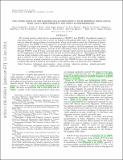TWO UPPER LIMITS ON THE ROSSITER-MCLAUGHLIN EFFECT, WITH DIFFERING IMPLICATIONS: WASP-1 HAS A HIGH OBLIQUITY AND WASP-2 IS INDETERMINATE
Author(s)
Albrecht, Simon H.; Winn, Joshua Nathan; Johnson, John Asher; Butler, R. Paul; Crane, Jeffrey D.; Shectman, Stephen A.; Thompson, Ian B.; Narita, Norio; Sato, Bun'ei; Hirano, Teruyuki; Enya, Keigo; Fischer, Debra A.; ... Show more Show less
Downloadwinn09.pdf (2.035Mb)
OPEN_ACCESS_POLICY
Open Access Policy
Creative Commons Attribution-Noncommercial-Share Alike
Terms of use
Metadata
Show full item recordAbstract
We present precise radial-velocity (RV) measurements of WASP-1 and WASP-2 throughout transits of their giant planets. Our goal was to detect the Rossiter-McLaughlin (RM) effect, the anomalous RV observed during eclipses of rotating stars, which can be used to study the obliquities of planet-hosting stars. For WASP-1, a weak signal of a prograde orbit was detected with [almost equal to]2omega confidence, and for WASP-2 no signal was detected. The resulting upper bounds on the RM amplitude have different implications for these two systems because of the contrasting transit geometries and the stellar types. Because WASP-1 is an F7V star, and such stars are typically rapid rotators, the most probable reason for the suppression of the RM effect is that the star is viewed nearly pole-on. This implies that the WASP-1 star has a high obliquity with respect to the edge-on planetary orbit. Because WASP-2 is a K1V star, and is expected to be a slow rotator, no firm conclusion can be drawn about the stellar obliquity. Our data and our analysis contradict an earlier claim that WASP-2b has a retrograde orbit, thereby revoking this system's status as an exception to the pattern that cool stars have low obliquities.
Date issued
2011-09Department
Massachusetts Institute of Technology. Department of Physics; MIT Kavli Institute for Astrophysics and Space ResearchJournal
Astrophysical Journal
Publisher
Institute of Physics Publishing
Citation
Albrecht, Simon et al. “TWO UPPER LIMITS ON THE ROSSITER-MCLAUGHLIN EFFECT, WITH DIFFERING IMPLICATIONS: WASP-1 HAS A HIGH OBLIQUITY AND WASP-2 IS INDETERMINATE.” The Astrophysical Journal 738.1 (2011): 50. Web.
Version: Author's final manuscript
ISSN
0004-637X
1538-4357